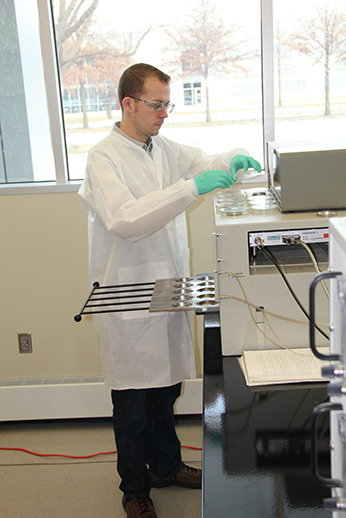
| Jan. 2017 | |||||||||||
| Top stories | |||||||||||
| In the news | |||||||||||
| Photos | |||||||||||
| Contact us | |||||||||||
| Archive | |||||||||||
|
Researchers study polonium in coal waste water |
Jan. 31, 2017 --
The State Hygienic Laboratory played an instrumental role in a collaboration of Iowa researchers studying radioactive waste from coal mining, with surprising conclusions.
 Dustin May works in the State Hygienic Laboratory Radiochemistry lab.
Dustin May works in the State Hygienic Laboratory Radiochemistry lab.Their scientific paper, published in the Journal of Environmental Radioactivity, noted that while coal-mine waste can contaminate the environment with naturally occurring radioactive nuclides, the behavior of one of those – polonium-210 – is largely unexplored.
The highly toxic radioactive metal made headlines in 2006 when it was used to kill a former Russian spy in London.
Polonium-210 has a half-life of just 138 days and decays to stable lead, by the emission of alpha particles. While alpha particles can be stopped with a piece of paper and are unable to penetrate the skin, they are capable of causing serious cell damage if ingested. It was confirmed in post-mortem tests that this was the cause of death for former spy Alexander Litvinenko, who was poisoned when he drank Polonium-210 that had been added to his tea.
Dustin May, radiochemistry and nutrient demand laboratory supervisor for the State Hygienic Lab, said the collaboration with the University of Iowa Department of Chemistry, Interdisciplinary Human Toxicology Program, Department of Environmental and Occupational Health and Departments of Radiology and Radiation Oncology, Free Radical and Radiation Biology Program, stemmed from prior work examining hydraulic fracturing waste.
"When you drill for any materials – coal or natural gas – you end up with radioactive waste," May said. "It's a well-known problem."
What is lesser known, however, are the environmental health implications of polonium-210 accumulation in lake-bottom sediments. Polonium-210 is difficult to investigate because of its radiochemical properties and the specialized equipment needed to study the nuclide.
Researchers sought to discover if the polonium-210 concentrations found in two West Virginia sites contaminated with coal mine discharges were natural or caused by humans.
The investigators used a lake at F.W. Kent Park, near Oxford, Iowa, as a control in the study. The lake was selected because of its similar size and three seasons of rainfall, as well as its history with no prior mining activities.
The team compared samples from the Iowa lake to those taken from a site near Wana, West Virginia, where overflow from a coal mine holding pond resulted in a 30-mile fish kill along Dunkard Creek in 2009.
The other site was near Mannington, West Virginia, where a mine drainage wastewater treatment plant was constructed as part of a legal settlement related to the Dunkard Creek spill. Treated liquid waste, generated from coal mining, had discharged into the adjacent Hibbs Run Reservoir on a wildlife management area.
Dustin May helped lead author Andrew Nelson, of the University of Iowa Department of Chemistry, collect the Iowa lake water and sediment samples, while other researchers collected samples in West Virginia.
The Hygienic Laboratory analyzed samples for metals, inorganics and organics, and performed the gamma-ray spectrophotometry. Alpha spectrometry was performed on the samples in the Chemistry Department at the University of Iowa.
Somewhat surprisingly, the results from the West Virginia sites were similar to the samples taken in Iowa, leading the researchers to suggest the polonium-210 concentrations were naturally occurring, rather than a byproduct of coal mining.
The authors note that the findings of the study suggest that the natural accumulation and retention of polonium-210 in lake sediments may be greater than previously considered, and careful selection of control sites is important to prevent the inappropriate attribution of elevated levels in lake-bottom ecosystems to industrial sources.
"We generally don't see it at high enough concentrations for acute poisoning," May said, noting that the levels detected in the study were orders of magnitude lower than the concentrations involved in the Russian spy case.
Further study is needed, however, on the potential for bioaccumulation in fish and subsequent harm to humans or wildlife that ingest the fish, he said, as polonium-210 can increase the risk for certain types of cancer.
The work was funded by the University of Iowa Center for Health Effects from Environmental Contaminants and the University of Iowa Center for Global and Regional Environmental Research.